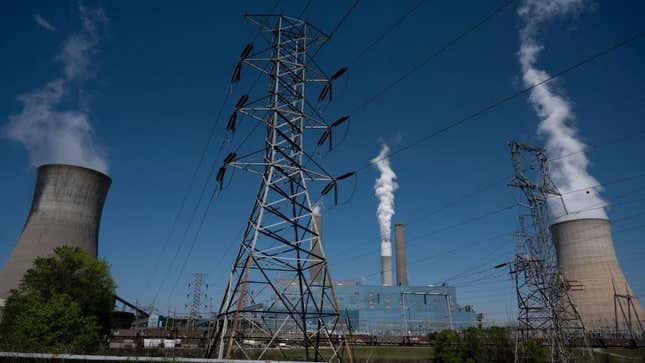
The Supreme Court recently heard oral arguments for a case that could weaken the U.S. Environmental Protection Agency’s ability to regulate air pollution. Depending on how the court decides the case of West Virginia v. EPA, the EPA could lose some of its regulatory powers, including regulating greenhouse gas emissions. If that happens, it could be a blow to Biden’s climate agenda, including plans to reach net zero emissions by 2050. And more importantly, it could lock the U.S. on a path to even worse climate disaster.
This case is complicated and based on long-standing legal issues over a policy pushed by former president Barack Obama (and another, weaker version put forward under Donald Trump) designed to regulate power-plant emissions. The plaintiffs—which include representatives from Republican-led states, the owners of various coal mines, and energy companies—have argued that regulations are unconstitutional and could hurt the energy sector. The lawsuit is being led by West Virginia Attorney General Patrick Morrisey, who has called for SCOTUS to issue a ruling before the Biden administration can unveil future power plant regulations, the Washington Post reported.
Morrisey is the attorney general who sued President Obama back in 2016 over the Clean Power Plan, which prompted the Supreme Court to put the regulation on hold for the rest of the administration. The plan was then repealed by the Trump administration in 2017. The Biden administration now wants to significantly reduce greenhouse gas emissions, but the politicians in power in several states do not want the fossil fuel industry to face strict regulations, and so the attorney generals of those states hope to strike down future regulatory efforts before they are passed and enforced.
Kirti Datla, director of strategic legal advocacy at Earthjustice, explained that the main question being unpacked in this court case is how much authority the EPA has to regulate emissions from existing power plants under a specific provision of the Clean Air Act 111 d. According to a report from Congress about the Clean Air Act, the provision gives the agency the “authority to limit greenhouse gases from existing power plants” through “the 2015 Clean Power Plan and the 2019 Affordable Clean Energy.” Neither the Clean Power Plan nor the Affordable Clean Energy rule have been implemented.
“That is important, because the power sector is a third of our [CO2] emissions. There are a lot of existing power plants, and regulating those emissions is important for addressing climate change,” Datla told Earther.
The Supreme Court is usually asked to interpret a statute, but in this case, West Virginia (and all the entities being represented on that side of the case) are asking the Court to apply a major questions doctrine, which places limits on agencies’ ability to regulate issues of “major economic and political significance.” This means that the EPA cannot write a rule that would change its regulatory authority without congressional approval. Datla explained that, if the courts sided with West Virginia, it would mean that Congress would have to give the EPA clearance every time it wants to regulate a pollutant. This ruling could also stop Congress from delegating authority to other regulatory agencies as well, SCOTUSblog notes.
“It’s going to really hold Congress to a higher burden of proof than it would in a normal case… that has the potential to be effectively deregulatory,” Datla said.
However, if the court rules in favor of the EPA, the agency doesn’t have to change, and the current status quo for regulation is upheld. “Congress passes statutes, agencies issue regulation... sometimes the agencies win, sometimes agencies lose. It’s better in terms of the EPA’s ability to address emissions,” Datla explained. “The potential for [major] change is really on one side [of this case].”
The justices’ decision on this case is expected this summer. The current Supreme Court is currently at a conservative majority of 6-3, worrying environmental advocates who suspect this foreshadows the outcome.